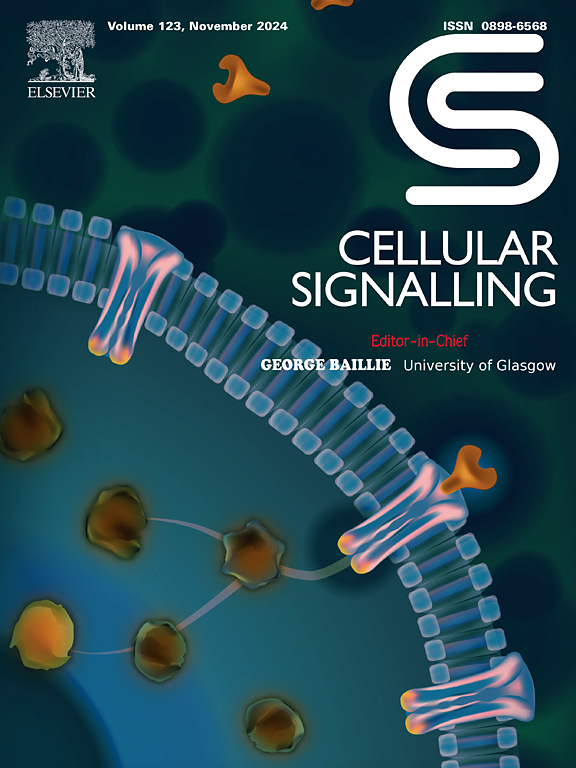EIF2B5通过靶向RPL6激活PI3K/AKT信号通路,促进肝癌恶性进展
IF 4.4
2区 生物学
Q2 CELL BIOLOGY
引用次数: 0
摘要
肝细胞癌(HCC)是一种高度侵袭性的恶性肿瘤,治疗选择有限,预后差。在这项研究中,我们证明了EIF2B5在推动HCC进展中的关键作用。在包括The Cancer Genome Atlas在内的多个生物信息学数据集中,我们发现EIF2B5在HCC肿瘤组织中的表达显著上调,并且EIF2B5的高表达预示着HCC患者预后不良。通过一系列体外细胞生物学实验,我们发现EIF2B5敲低显著减弱Hep3B和HepG2的增殖、迁移和侵袭,增加细胞周期阻滞,而EIF2B5过表达促进HCC进展。通过质谱和免疫沉淀验证,我们发现EIF2B5直接与RPL6相互作用,当EIF2B5在HCC细胞中过表达时,可促进下游蛋白RPL6的表达,激活磷脂酰肌醇激酶(PI3K)/丝氨酸-苏氨酸激酶(AKT)/哺乳动物雷帕霉素靶蛋白(mTOR)通路,从而提高HCC细胞系的增殖和侵袭能力。经第二代测序分析和western blot验证。我们通过小鼠异位肿瘤实验进一步验证了这些发现,结果表明EIF2B5敲低可显著抑制HCC小鼠的肿瘤进展。本研究提示,EIF2B5通过与RPL6相互作用,激活PI3K/AKT/mTOR信号通路,促进HCC恶性进展,可能是治疗HCC的潜在靶点。本文章由计算机程序翻译,如有差异,请以英文原文为准。
EIF2B5 promotes malignant progression of hepatocellular carcinoma by activating the PI3K/AKT signaling pathway through targeting RPL6
Hepatocellular carcinoma (HCC) is a highly aggressive malignancy with limited treatment options and poor prognosis. In this study, we demonstrated the critical role of EIF2B5 in driving HCC progression. We found EIF2B5 expression is significantly upregulated in HCC tumor tissues in several bioinformatics datasets, including The Cancer Genome Atlas, and that high expression of EIF2B5 predicts poor prognosis for HCC patients. Through a series of in vitro cell biology experiments, we found that EIF2B5 knockdown significantly attenuated Hep3B and HepG2 proliferation, migration, and invasion and increased cell cycle arrest, whereas EIF2B5 overexpression promoted HCC progression. Through mass spectrometry and immunoprecipitation validation, we found that EIF2B5 directly interacted with RPL6 and that when EIF2B5 was overexpressed in HCC cells, it promoted the expression of the downstream protein RPL6, which was able to activate the phosphatidylinositol kinase (PI3K)/serine-threonine kinase (AKT)/mammalian target of rapamycin (mTOR) pathway and thereby increase the proliferation and invasion ability of HCC cell lines, as verified by second-generation sequencing analysis and western blot. We further verified these findings using the mouse ectopic tumor assay, and the results showed that EIF2B5 knockdown significantly inhibited tumor progression in HCC mice. The present study suggests that EIF2B5 promotes malignant progression of HCC by interacting with RPL6 and activating the PI3K/AKT/mTOR signaling pathway and may serve as a potential target for the treatment of HCC.
求助全文
通过发布文献求助,成功后即可免费获取论文全文。
去求助
来源期刊

Cellular signalling
生物-细胞生物学
CiteScore
8.40
自引率
0.00%
发文量
250
审稿时长
27 days
期刊介绍:
Cellular Signalling publishes original research describing fundamental and clinical findings on the mechanisms, actions and structural components of cellular signalling systems in vitro and in vivo.
Cellular Signalling aims at full length research papers defining signalling systems ranging from microorganisms to cells, tissues and higher organisms.
 求助内容:
求助内容: 应助结果提醒方式:
应助结果提醒方式:


